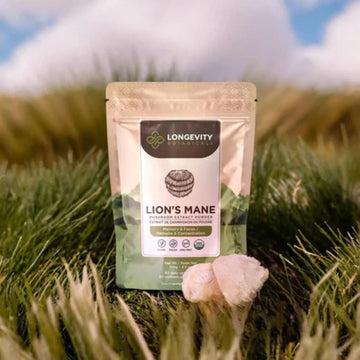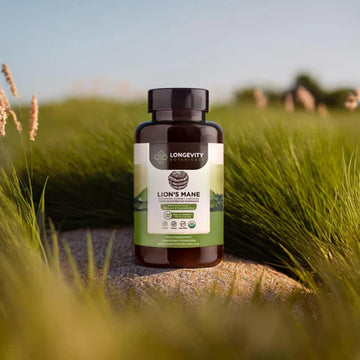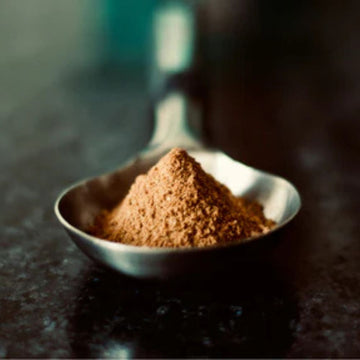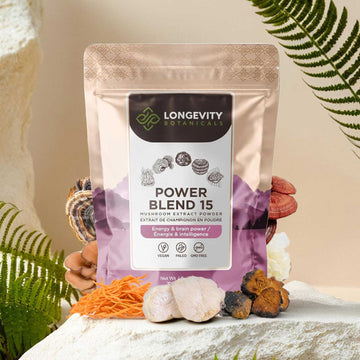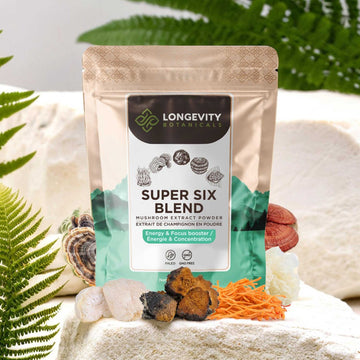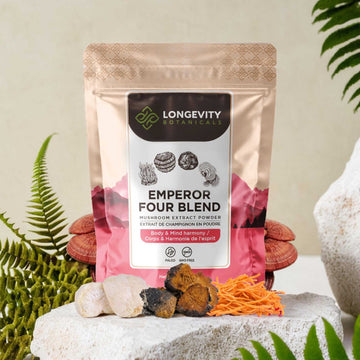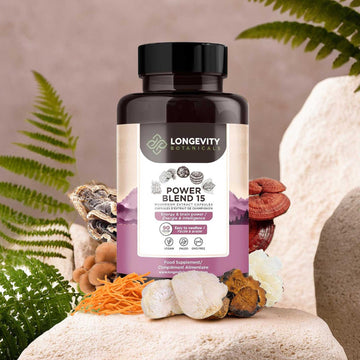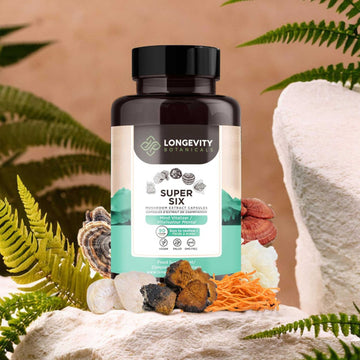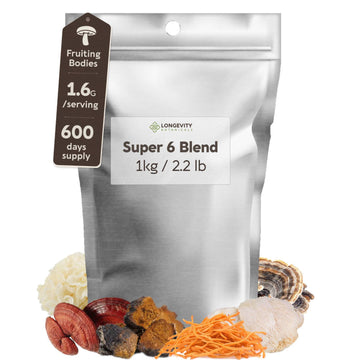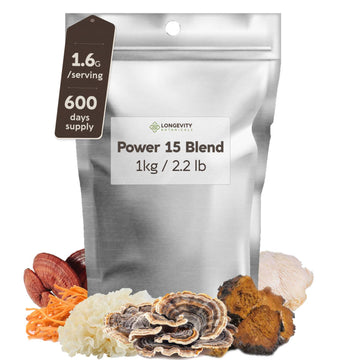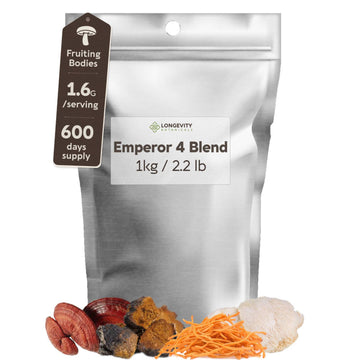Two Growth Stages, Two Very Different Chemistries
The word “mushroom” can mean two things. One is the fruiting body, the familiar cap-and-stem that pops from a log or forest floor. The other is mycelium, the hidden web of threads that lives inside wood, soil, or, in many factories, plastic bags filled with grain.
Although both stages belong to the same organism, they face different challenges. Fruiting bodies must stand upright, push through air, and release spores. To stay strong, they thicken their cell walls with branching beta (1 → 3)(1 → 6) glucans, much like steel rods in concrete. Mycelium creeping through soft oatmeal or rice has no such structural burden, so it saves energy by growing fast and light.
On the farm this difference is magnified. A cultivator might harvest the entire grain block, mycelium plus cereal, dry it, and grind it into powder. Up to half that powder is plain starch. By contrast, a pure fruiting body is close to 100 % fungal tissue, free of cereal filler and rich in its own protective compounds. Readers wanting a deeper dive on life-stage anatomy can explore our article here.
The Beta Glucan Advantage
What beta glucans do. Beta glucans are special fibers that fit immune receptors such as Dectin-1, CR-3, and TLR-2. When these receptors switch on, they rally macrophages, natural-killer cells, and other defenders that patrol the bloodstream.
How much is inside. Independent labs have compared matched samples again and again:
- Shiitake fruiting bodies often test 30–50 % beta glucan by dry weight, while the same strain’s mycelium scores 15–25 %.
- Reishi mushrooms average around 25–35 % beta glucan, yet grain-grown reishi mycelium can fall below 7 %.
- Wild chaga cankers chart a beta-to-alpha glucan ratio above fifteen to one, whereas oat-fermented “chaga” powders flip that ratio upside down.
Across dozens of species, the gap lands between five and fifteen times more immune-active beta glucans in fruiting bodies than in grain-grown mycelium. A 2023 review in Frontiers in Nutrition confirmed the pattern by pooling data from seventy studies.
Why dose size matters. Many human trials use about 300 mg beta glucan per day. Reaching that target with a high-potency 30 % fruiting-body extract takes a single one-gram serving. Hitting it with a six-percent mycelium powder would demand five grams—five times the capsules, cost, and effort.
More Than Beta Glucans: The Hidden Treasure in Caps and Stems
While beta glucans steal the spotlight, fruiting bodies bring an entire support cast of rare molecules.
Triterpenes. Reishi and chaga mushrooms make bitter triterpenes, such as ganoderic acids and inotodiol. These lipids show stress-modulating and antioxidant actions in cell studies. They come mainly from wood-like substrates, not from cereal grains. Pure fruiting-body reishi concentrates up to 4 % triterpenes, yet grain mycelium often shows “not detected.”
Ergosterol. This fungal form of vitamin D precursor strengthens cell membranes but sinks when cereal starch dilutes the biomass. Less ergosterol means weaker antioxidant potential.
Phenolic antioxidants. Lignin-rich logs supply mushrooms with building blocks that mycelium later converts into polyphenols. Oat or rice media lack these blocks, so phenolic levels stay low.
Taste and aroma clues. The woody, earthy flavor of a true mushroom comes from compounds like 1-octen-3-ol. Grain mycelium powders can smell like breakfast cereal because grain volatiles dominate.
Three Key Reasons Grain Mycelium Scores Lower
1. Starch Dilution
If half of the dried powder is still grain, then only the remaining half can carry beta glucans. Imagine mixing strong coffee with plain oatmeal. The more oatmeal you add, the weaker each sip tastes. Starch also shows up in lab tests as alpha glucan, an inactive form that does little for immunity.
2. Growth-Stage Biology
Vegetative hyphae are like seedlings racing for sunlight. They spread fast and thin, conserving resources. Without the need to stand tall, they stop weaving the thick beta glucan net found in a mature cap. Less net equals lower test results.
3. Missing Precursors
Many signature mushroom compounds start as molecules borrowed from hardwood or conifer resin. Grain supplies simple carbohydrates but few of these aromatic precursors. As a result, mycelium may never build ganoderic acid, betulinic acid, or strong melanin pigments.
Why “Total Polysaccharides” Is Not Enough
Not all polysaccharides do the same job. Beta glucans activate immune cells, but alpha glucans—mostly plain starch from grain—do not. When a label lists only “polysaccharides,” it lumps these very different molecules together, hiding how much immune-active beta glucan you actually get.
Grain dilutes the math. Mycelium grown on rice or oats can leave up to half the final powder as leftover cereal. That starch shows up in the lab as alpha glucan, inflating the total polysaccharide number while real beta glucan stays low.
A 30 percent “polysaccharide” claim can mean only 5 percent beta glucan. In many audits, products with 30 percent total polysaccharides turned out to deliver barely one-sixth of that as beta glucan once starch was subtracted.
Quality labs separate the two. Modern methods report beta glucan and alpha glucan side by side. Without that split, you cannot know whether you are buying immune fuel or paying for oatmeal filler.
Bottom line: Trust labels that state the beta glucan percentage explicitly and keep alpha glucan low. Skip any product that hides behind a single “total polysaccharides” line.
Real-World Impact on Your Daily Scoop
Capsule count. A bottle that lists “1 g serving, 30 % beta glucan” gives the same immune charge as five one-gram servings of 6 % mycelium. That is the difference between one capsule or five.
Flavor loading. High-potency extracts taste like concentrated mushrooms, so you need less to flavor a smoothie. Low-potency powders demand spoonfuls, adding a bland cereal taste instead of umami depth.
Long-term cost. Paying for beta glucan, not for starch, stretches the wellness budget. A side-by-side price check often shows fruiting-body extracts give two to three times more active molecules per dollar.
How to Choose Products That Deliver
Read the ingredient line. Look for phrases such as “fruiting body extract” or “100 % mushrooms.” Phrases like “mycelial biomass,” “full spectrum,” or “mycelium on brown rice” usually signal grain content. For a balanced view of grain pros and cons see our detailed guide.
Check beta glucan numbers. Reputable brands print beta glucan percentages on the label. Anything under 15 % suggests dilution or a low-potency species.
Putting the Evidence Together
Mushrooms evolved a clever strategy. The underground stage gathers fuel, while the above-ground stage invests that fuel into a fortified spore factory rich in defense compounds. Modern science confirms what ancient herbalists sensed by taste and effect. When you capture the whole fruiting body you unlock peak levels of beta glucans, triterpenes, sterols, and antioxidants. When you harvest mycelium plus grain you get a softer, starchier product that demands larger doses to approach the same activity.
The choice is simple. For immune support, stress balance, and antioxidant lift, choose supplements that state fruiting body extract, high beta glucan, low starch. Your body gets more active compounds, and your wallet avoids paying for oatmeal filler.
Bottom line: Real mushrooms build real strength, in forests and in your capsule. Let fruiting bodies do the heavy lifting for you.
